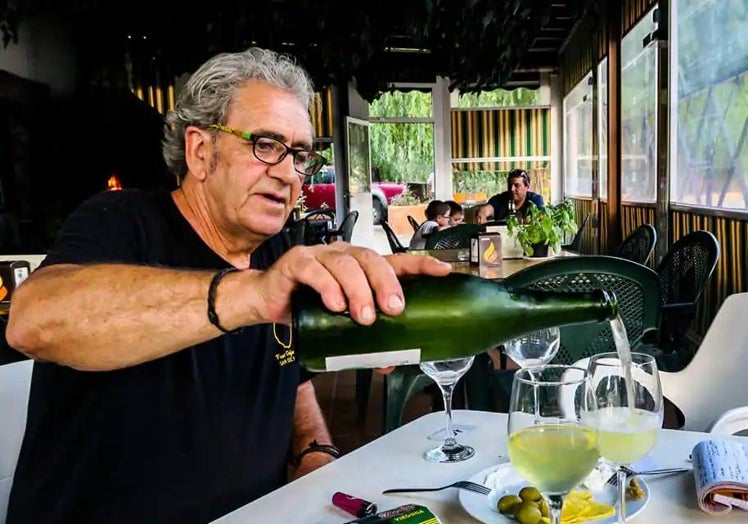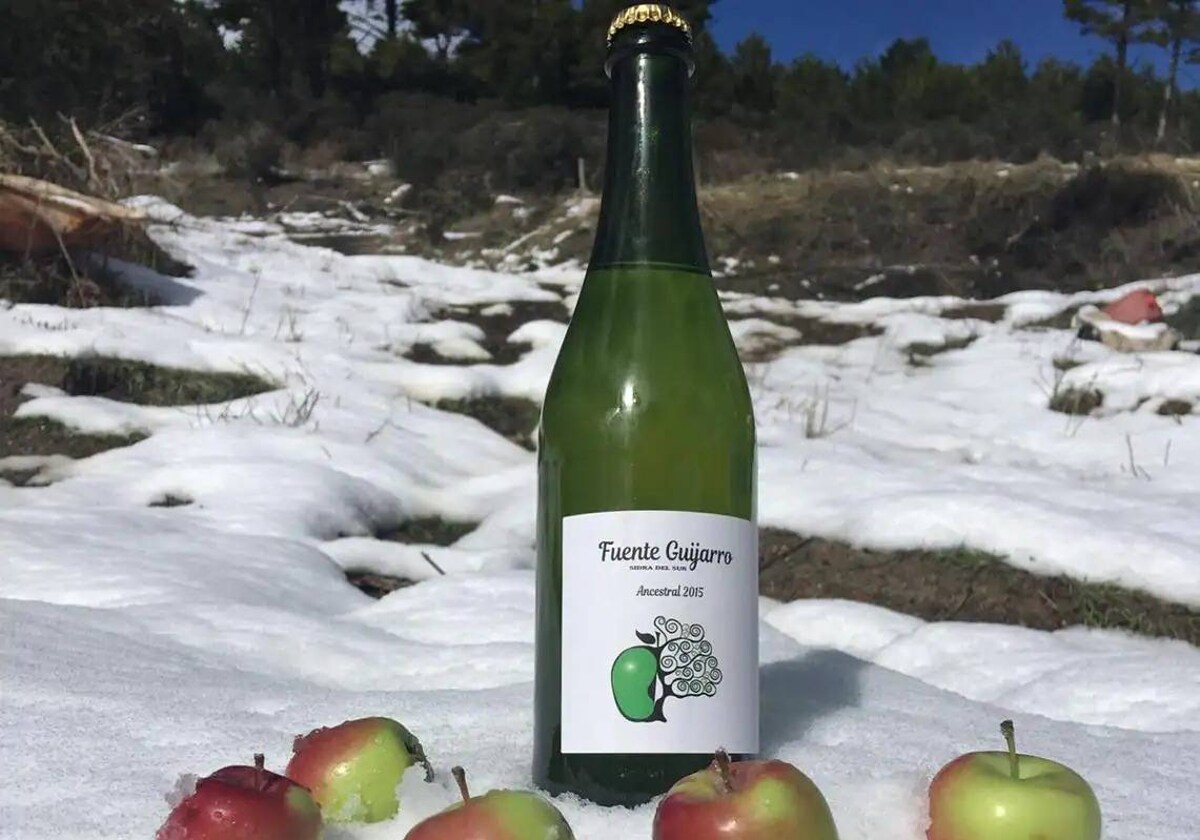The exclusive cider made in Granada's Sierra Nevada at 2,000 metres above sea level
Bodega Sidra del Sur-Fuente Guijarro, which produces all-natural 'apple cava', is the only one in Andalucía and the highest in Europe
Daniel Olivares
Granada
Friday, 12 April 2024, 15:21
Cider is said to have been consumed as far back as Roman times by the inhabitants of Asturias, the cider region par excellence in Spain (along with the Basque Country), although the first documented sale and purchase reference of the alcoholic beverage dates back to 904 AD. It is also traditional in countries including France, England, Belgium, Ireland and Germany.
In southern Europe the cultivation of grapes and other products has always prevailed and cider has never been a common drink, with the exception of Asturias, the Basque Country and some areas of Galicia. However, for a quarter of a century the province of Granada has been home to the first and only cider house in Andalucía.
As its creator Manuel Moreno, says, "From Madrid down I have no record of any other, the closest one is in Segovia." In addition, Bodega Sidra del Sur-Fuente Guijarro is probably the highest cider house in Europe, at almost 2,000 metres above sea level.
It is located in Granada province's Alpujarra, in the Sierra Nevada Natural Park and Manuel Moreno and Sara Bertani are the people behind it. The first creations began back in the 1990s when Moreno settled on the estate where they produce their "apple cava", as he likes to call it.
He had previously lived in Pampaneira, working in a carpentry workshop. But he decided to leave the job to move further east and work in agriculture on the Fuente Guijarro estate, which, although it is in the municipality of Válor, it borders Yegen. "Let's say that physically we are in Yegen, but legally we belong to Válor," says Moreno. Born in Madrid, he decided to head to the south more than forty years ago, towards the Alpujarra and to a more natural world.
The forgotten trees
In 1999 the first 'serious' cider was born. And 25 years later, in 2024, Fuente Guijarro now produces between four and five different varieties, depending on the harvest, made in a completely artisanal and natural way; the old-fashioned way. In fact, it is so traditional that a large part of the apple harvesting is done using mules.
This is the only way to transport the fruit from the two plots they have in La Ragua. As they are located in the Sierra Nevada Natural Park, they cannot do it by vehicle, so they take the sacks down three by three by mule to the nearest road where modern transport can reach them.
"It is approximately a fifteen-minute walk to this point, and we get there on mules or horseback. It is a rite and we like it very much that way, says Moreno, who in addition to making cider, safeguards the few old apple trees that were left in the area.
"During this time I have seen how the apple trees are disappearing from the rural landscape of the Alpujarras. The extensive cultivation of cherry tomatoes and green beans has led to the apple trees being cut down to make space for them," he explains.
Moreno adds that the felling and abandonment of traditional family subsistence agriculture have almost led to the complete disappearance of these fruit trees throughout the are. "The few apple orchards, almost all of which have been abandoned due to their lack of profitability, are also disappearing," he explains.
And the fact is that his cider, or ciders, apart from the altitude, have another common denominator. They are made with 'peros'; a type of apple native to the area from trees that were close to extinction and that he and Sara decided to protect.
"They are botanical relics in extreme danger of extinction. We are aware of the existence of only one specimen, a single tree, and unfortunately in recent years we have also recorded the total disappearance of some other varieties, as the last known specimen has been lost," he explains.
"One of our main objectives has been the recovery and conservation of the different varieties of these almost extinct trees. We have achieved in our nursery what is today the only bank for the conservation of these relics; the oldest and noblest native apples. We plant new crops on our plots and give saplings to people who are sensitive to our attempt to preserve and make this crop profitable," Moreno says.
For more than 30 years they have compiled all the information given to them by "the oldest of the farmers", while taking cuttings from as many trees with these varieties as possible "through painstaking and interminable research". They call them the "forgotten trees".

Hortel Cava
On the Fuente Guijarro estate, named after the spring that irrigates it, the most common variety is the 'pero Hortel'. "The apples grown on the higher farms in the sierra were late-ripening, some not sweetening until late December when, after harvesting, they were carefully placed on racks of reeds or on a bed of rye straw, so that they could be kept all winter in a perfectly ripe state until the following summer. This was a supply of fresh fruit in the long winters," Moreno explains.
It is these Serrano apples that give Fuente Guijarro cider its uniqueness. The acids and aromas introduced into this 'apple cava' are what give this cider its own personality, which is quite different from the more classic ciders of the north of Spain or others that are sold in supermarkets. Moreover, the ageing method they use is more similar to the traditional method used to produce French champagnes and Catalan cavas.
The range of varieties moves between those made naturally with their own retained carbon and those double fermented with their own juices, giving characteristics more akin to a sparkling white wine than a cider. "The process is the same as the one Dom Perignon created in his day. That's why I say it's an apple cava. Some people, after tasting it, have asked me what grape variety it was," Moreno laughs.
They use up to nine varieties of apples which, combined in different ways, give meaning to their different labels: La Ragua, Fuente Guijarro Ancestral, Fuente Guijarro Método Clásico, Eva and Quimera.
The naturalness is also noticeable in the sulphites, antioxidants which always oscillate below five milligrams per litre (European legislation sets a limit of 10 mg/litre). In terms of alcohol content, it far exceeds traditional ciders, which are around four or five per cent. These Alpujarra ciders are close to the status of wine with 7.5 per cent alcohol.
95 per cent of production is exported
Do the people of Granada consume Sidra del Sur? The truth is they don't, and that most of Fuente Guijarro's production, limited to around 5,000 bottles a year, is exported outside Spain, to countries such as France, Germany and Belgium, where there is a greater tradition of consumption of this type of cider and where it is more appreciated.
It is also appreciated in Catalonia, Valencia and the Balearic Islands, Manuel Moreno points out. Only a small amount of the production stays and is distributed in the province. Ninety-five percent goes abroad. This is why Manuel and Sara attend several of the natural wine fairs held in these countries, in Madrid and Barcelona every year. And the nearest airport is more than two hours' drive from Yegen.
